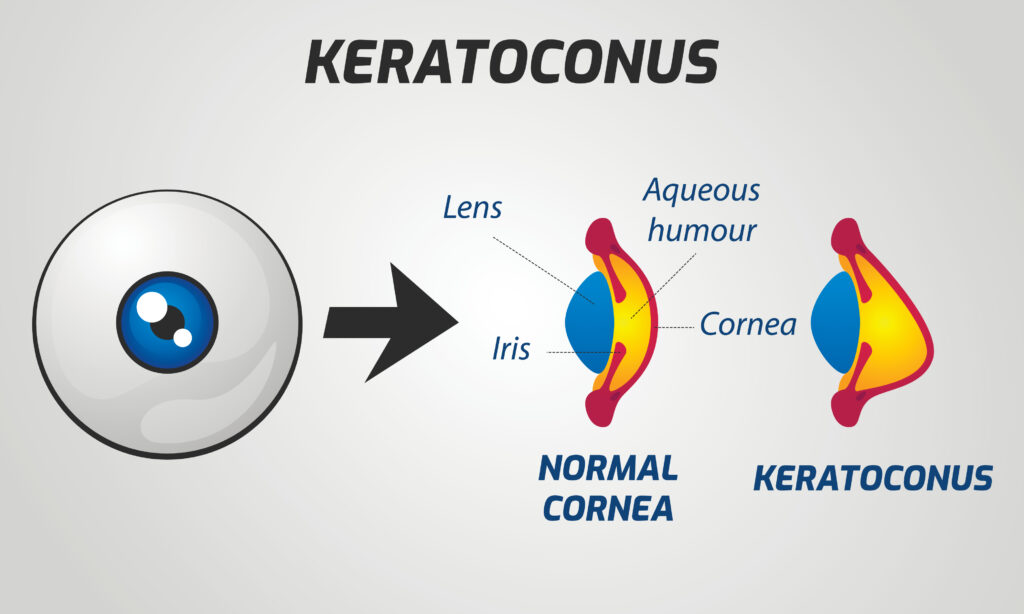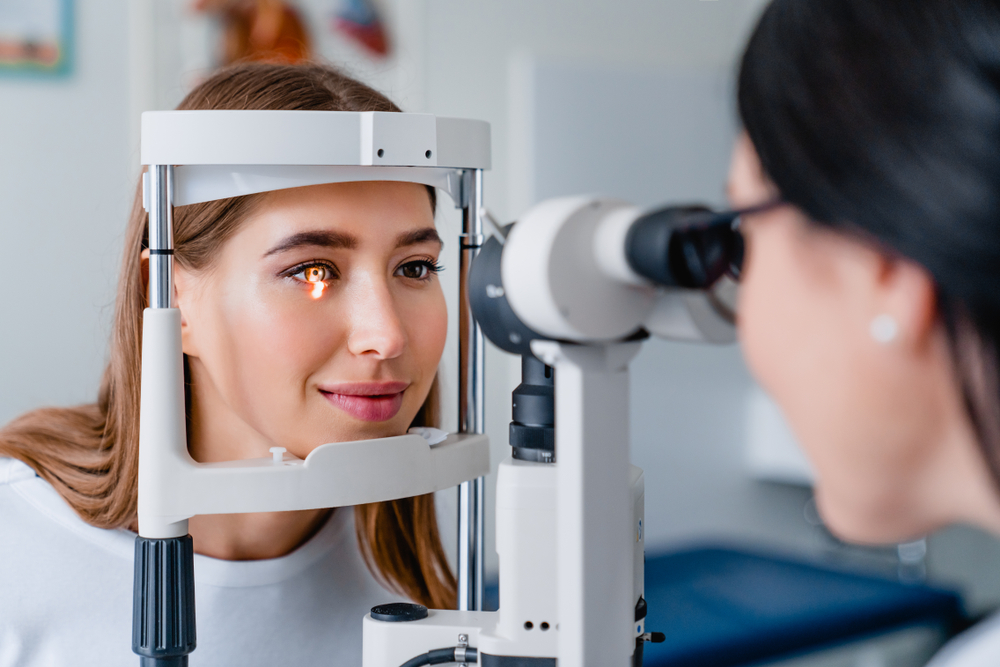
Updated: August 04, 2025
While a keratoconus diagnosis might initially seem overwhelming, patients today have access to more effective treatment options than ever before. From specialized contact lenses to groundbreaking procedures like corneal cross-linking, modern eye care offers hope and clear vision for those affected by this progressive corneal condition.
Keep reading to learn about keratoconus and how it’s treated!

Keratoconus alters the structure of your cornea, which is the clear, dome-shaped front surface of your eye. Under normal circumstances, your cornea maintains a uniform, spherical curvature that helps focus light precisely onto your retina.
However, keratoconus causes the corneal tissue to become progressively thinner and weaker, leading to an abnormal bowing or bulging effect that resembles a cone shape. This structural change typically begins during the second and third decades of life, making it particularly relevant for teenagers and young adults.
The irregular corneal surface that results from keratoconus creates what eye care professionals refer to as irregular astigmatism. Irregular astigmatism is a complex visual distortion that cannot be adequately corrected with standard glasses or regular contact lenses.
The progression of keratoconus varies significantly from person to person. Some individuals experience rapid changes over months, while others may see gradual progression over years.
This unpredictability is why regular monitoring and early intervention strategies are so important to help preserve vision and prevent more severe complications.

The symptoms of keratoconus often develop gradually, which can make early detection challenging. However, recognizing these warning signs can lead to a timely diagnosis and more effective treatment.
The most common signs include needing new glasses or contacts much more often than normal, usually because astigmatism is getting progressively worse. Many patients first notice that their vision remains blurred or distorted even with newly prescribed glasses or contact lenses.
This persistent blurriness occurs because normal lenses can’t correct the irregular cornea shape associated with keratoconus. Light and glare sensitivity also worsens, especially when driving at night or under bright office lighting.
Young adults experiencing these symptoms should visit their eye doctor right away. Early detection remains the most powerful tool available for preventing the progression of vision loss.
The earlier keratoconus is identified, the more treatment options are available to preserve corneal structure and prevent the need for more invasive interventions.
While researchers are still studying what exactly causes keratoconus, current evidence suggests it’s a combination of genetics and environmental factors.
Most people with keratoconus have a genetic tendency toward the condition, meaning family history plays an important role in determining risk.
Excessive eye rubbing can also significantly exacerbate the progression of the condition. The mechanical stress from frequent eye rubbing weakens the already compromised corneal structure, speeding up the irregular shape changes that characterize keratoconus.
Keratoconus treatment has improved dramatically over the past decade, giving patients more options than ever before. The main goal of any treatment is to help you see as clearly as possible while stopping the condition from getting worse.
For many patients with keratoconus, specially designed contact lenses provide the most effective vision correction. Rigid gas permeable (RGP) lenses create a smooth, regular front surface that masks the irregular corneal shape underneath. These smaller lenses sit primarily on the cornea and can dramatically improve visual acuity compared to glasses.
Scleral lenses represent another excellent option, particularly for patients who find RGP lenses uncomfortable. These larger, rigid lenses rest on the white portion of the eye and vault completely over the cornea. The tear layer that fills the space between the lens and cornea creates a perfectly smooth optical surface, often providing exceptional vision quality and comfort.
Hybrid lenses combine the visual benefits of rigid lenses with the comfort advantages of soft lenses. The rigid center portion corrects the irregular astigmatism, while the soft outer edge enhances comfort and stability on the eye.
Corneal cross-linking (CXL) represents one of the most significant advances in keratoconus treatment. This minimally invasive outpatient procedure uses riboflavin (vitamin B2) eye drops combined with controlled ultraviolet light exposure to create new chemical bonds between collagen fibers in the cornea.
The cross-linking process increases corneal rigidity and mechanical strength, effectively halting the progressive thinning and bulging that characterizes keratoconus. While CXL cannot reverse existing irregular astigmatism, it can prevent further deterioration and preserve the corneal structure for years to come.
When other treatment options prove insufficient, surgical interventions may become necessary. INTACS corneal ring segments can help regularize corneal shape in advanced keratoconus cases. These semicircular implants are placed in the corneal periphery to reduce irregular astigmatism and improve overall corneal contour.
Corneal transplant surgery remains the final treatment option for the most severe cases of keratoconus. Modern techniques include both full-thickness transplants and partial-thickness procedures that preserve healthy inner corneal layers. While transplantation can restore vision in advanced cases, it requires careful long-term management and carries inherent surgical risks.

Keratoconus management requires specialized knowledge, advanced technology, and extensive experience with complex cases. At Discover Vision Centers, our team combines decades of clinical expertise with cutting-edge diagnostic and treatment technologies to provide comprehensive keratoconus care.
Our patient-centered approach recognizes that each individual’s needs, lifestyle, and goals are unique. Rather than applying one-size-fits-all treatment, we develop personalized management strategies that address both immediate visual needs and long-term eye health objectives.
Our advanced diagnostic technology allows us to create detailed maps of your cornea, leading to accurate diagnosis and personalized treatment plans. Beyond treating the condition itself, we’re committed to patient education, lifestyle guidance, and supporting you every step of the way.
Ready to take control of your vision? If you’re experiencing symptoms of keratoconus or have concerns about your eye health, schedule an appointment with the keratoconus specialists at Discover Vision Centers in Kansas City, MO, today to explore your treatment options and protect your vision for the future.
We are closed Monday (05/25)! Urgent Care is also closed Saturday (05/23)!
We are closed Friday (07/03)!
We are closed Monday (09/07)! Urgent Care is also closed Saturday (09/05)!
We are closed Thursday (11/26) and Friday (11/27)! Urgent Care is also closed Saturday (11/28)!